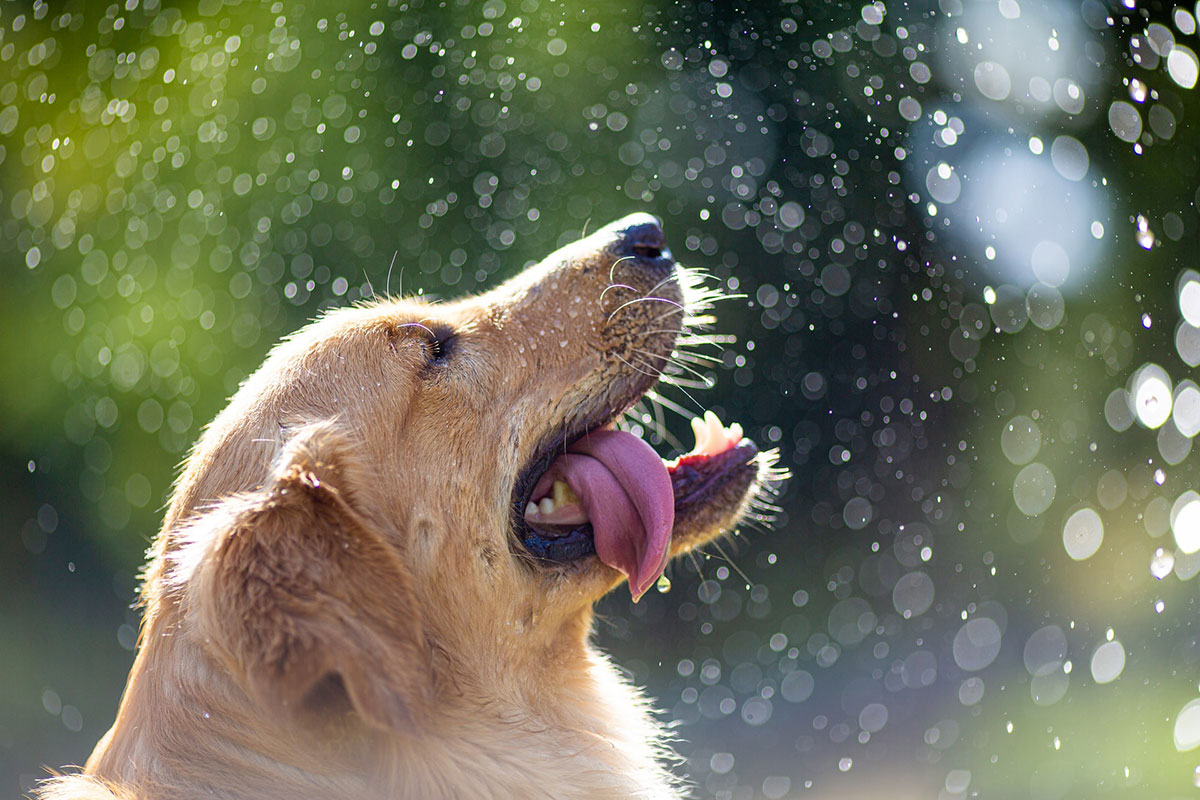Dog owners often wonder why their pets bark more. It’s not just about being excited or bored. Sometimes, seasonal allergies can be the reason. Dogs, just like humans, can get allergies that make them itch, scratch, and have skin problems.
These allergies can make dogs uncomfortable. This discomfort might make them bark more. It’s important for dog owners to know how allergies and barking are connected. This way, they can help their pets feel better.
Key Takeaways
- Dogs can suffer from seasonal allergies, just like humans.
- Allergies can cause discomfort, leading to increased barking.
- Identifying allergy symptoms is crucial for addressing barking issues.
- Seasonal allergies can lead to itching, scratching, and skin issues in dogs.
- Understanding the link between allergies and barking can help dog owners address their pet’s behavior.
Understanding Canine Seasonal Allergies
The seasons change, bringing beauty and allergens that affect dogs. Canine seasonal allergies are common, causing discomfort and distress for many dogs.
Common Allergens Affecting Dogs
Dogs can be allergic to pollen, dust mites, and mold. Grass allergies are common in dogs and can cause skin issues. For more information, visit this article.
Pollen Types and Their Seasonal Patterns
Different pollen types are released at different times. Tree pollen is common in spring, while grass pollen is in late spring and early summer. Knowing these patterns helps dog owners manage their pets’ allergies.
Indoor vs. Outdoor Allergens
Outdoor allergens like pollen are a big concern, but indoor allergens like dust mites and mold also affect dogs. Keeping both indoor and outdoor spaces clean can reduce exposure to allergens.

How Allergies Develop in Dogs
Allergies in dogs happen when their immune system overreacts to a substance. This can cause itching, scratching, and skin issues.
Breed Predispositions to Seasonal Allergies
Some breeds are more likely to have seasonal allergies due to their genetics. Breeds with sensitive skin or those often outdoors are more at risk. Knowing this can help owners protect their pets.
Recognizing Allergy Symptoms in Your Dog
Allergies in dogs can cause a lot of discomfort. It’s important for dog owners to know the signs. This way, they can get the right care on time.
Physical Symptoms of Allergic Reactions
Dogs with seasonal allergies show many physical symptoms. These can be divided into skin and coat issues, and problems with breathing and eyes.
Skin and Coat Changes
Skin irritation is a common sign of allergies in dogs. It can cause intense itching, redness, and hair loss. Some dogs may get hot spots or skin infections from scratching too much.
Coat changes include dullness, matting, or too much shedding. Regular grooming can spot these issues early.
Respiratory and Eye Symptoms
Dogs with allergies can have respiratory issues like sneezing, coughing, or a runny nose. Eye symptoms can be redness, itchiness, or discharge.

Behavioral Changes During Allergy Season
Allergies can also change a dog’s behavior. They might be more restless, whine, or bark because they’re uncomfortable. Some dogs may become clingy or withdrawn.
Distinguishing Allergies from Other Health Issues
It’s key to tell allergy symptoms from other health problems. These can look similar. Seeing a vet is important to rule out things like flea infestations, food allergies, or skin infections.
A vet will do a thorough check and might do tests. This helps figure out what’s causing your dog’s symptoms.
Seasonal Allergies and Increased Barking: The Hidden Connection
As the seasons change, many dog owners notice their pets bark more. They often think it’s because of something outside, but there’s a hidden link. Dogs with seasonal allergies may bark more than usual.
How Discomfort Triggers Excessive Barking
Seasonal allergies can make dogs uncomfortable, leading to more barking. Dogs with itching, skin irritation, or other symptoms get agitated. This agitation shows up as excessive barking.
The discomfort triggers a stress response, causing dogs to bark more. Knowing this helps dog owners find the cause of their pet’s barking.
Neurological Effects of Histamine Reactions
Histamine reactions are key in how dogs with seasonal allergies feel. When histamine is released, it can affect the dog’s nervous system. This can make them more sensitive and irritable.
This sensitivity can make dogs bark more because they notice their surroundings more. The neurological effects of histamine reactions are important in why allergic dogs bark more.
The Stress-Barking Cycle in Allergic Dogs
The stress-barking cycle is a vicious loop. Allergies cause stress and discomfort, leading to barking. This barking can make the dog even more stressed.
Sleep Disruption and Irritability
Allergies can mess up a dog’s sleep, making them irritable and bark more. Dogs who don’t sleep well are more stressed and anxious. This can make barking worse.
Sensory Hypersensitivity During Flare-ups
During allergy flare-ups, dogs can be more sensitive to their environment. This sensitivity can make them bark more as they react to things they might not usually notice.
By understanding the stress-barking cycle, dog owners can help their pets feel better. This might involve medical treatments, changing the environment, and training.
Identifying Allergy-Related Barking Patterns
Understanding the link between allergies and barking can help dog owners manage their pet’s behavior. Seasonal allergies can make dogs uncomfortable, leading to changes in their behavior, including barking patterns.
Timing and Frequency Changes
Changes in barking timing and frequency can indicate allergies. If your dog barks more during certain times or in specific places, it might be due to allergies. For example, barking more during pollen season could be an allergic reaction.
Intensity and Duration Variations
Allergies can also change how long and loud a dog barks. Dogs might bark louder or longer when they’re uncomfortable due to allergies. Monitoring these changes can help figure out if the barking is due to allergies.
Contextual Clues for Allergy-Triggered Barking
Understanding when the barking happens is key. Environmental triggers like pollen, dust, or certain plants can cause allergic reactions. Knowing these triggers can help manage the barking.
Environmental Triggers to Monitor
Common triggers include pollen from trees, grasses, and weeds, as well as dust mites and mold. Watching local pollen counts and avoiding high allergen areas can reduce your dog’s exposure.
Keeping a Symptom and Barking Journal
Keeping a journal of your dog’s symptoms and barking patterns is very helpful. By tracking when the barking happens and any other symptoms, you can spot patterns and potential causes. This info is crucial when talking to a vet.
By paying close attention to these factors and making necessary changes, dog owners can manage their pet’s allergy-related barking better.
Veterinary Diagnosis and Testing
Veterinary diagnosis and testing are key in finding and managing seasonal allergies in dogs. Getting an accurate diagnosis is crucial. It helps in creating a treatment plan that relieves symptoms and improves your dog’s life.
When to Consult Your Veterinarian
If your dog shows signs of seasonal allergies, like excessive barking or scratching, see your vet. They will check if these symptoms are from allergies or something else.
Early consultation is key to stop allergy symptoms from getting worse. It also lowers the chance of secondary infections or complications.
Common Allergy Tests for Dogs
Vets use different tests to find allergies in dogs. These include:
Blood Tests vs. Skin Tests
Blood tests check for allergy-related antibodies in your dog’s blood. Skin tests expose your dog’s skin to allergens to see reactions. The choice depends on your dog’s condition and history.
Elimination Trials
Elimination trials remove potential allergens from your dog’s environment or diet. This helps see if symptoms get better. It’s great for finding food allergies or sensitivities.
Interpreting Test Results and Creating Treatment Plans
After tests, your vet will understand the results to find the allergens affecting your dog. They’ll then create a treatment plan. This might include medicine, immunotherapy, or changes in your dog’s life to manage symptoms.
A collaborative approach between you and your vet is crucial. It’s important for managing your dog’s seasonal allergies well.
Medical Treatments for Canine Seasonal Allergies
There are many ways to treat canine seasonal allergies. Dog owners can choose from prescription meds to natural remedies. This helps ease their pets’ discomfort.
Prescription Medications and Their Effects
Prescription meds are often the first choice for treating allergies in dogs. They can quickly ease symptoms.
Antihistamines and Anti-inflammatories
Antihistamines fight histamine release in allergic reactions. They reduce itching, sneezing, and other symptoms. Anti-inflammatory meds help with swelling and pain from allergies.
Corticosteroids: Benefits and Risks
Corticosteroids are strong anti-inflammatory meds. They help dogs with severe allergies a lot. But, long-term use can cause side effects like weight gain and liver issues.
Immunotherapy Options
Immunotherapy, or allergy shots, is a long-term treatment. It makes dogs less sensitive to allergens. The treatment involves regular injections of small amounts of the allergen, gradually increasing the dog’s tolerance.
Natural and Supplemental Approaches
Natural and supplemental methods can also help dogs with seasonal allergies.
Omega Fatty Acids and Their Benefits
Omega-3 fatty acids have anti-inflammatory properties. They help reduce skin irritation and itching from allergies.
Herbal Remedies with Scientific Support
Certain herbal remedies may help with allergy symptoms. Herbs like turmeric contain curcumin, which is anti-inflammatory.
It’s crucial for dog owners to talk to their vet. Each dog’s allergies and treatment responses are different.
Environmental Management Strategies
To help your dog with seasonal allergies, managing their environment is key. Changing your home and daily routines can cut down on allergens your dog meets.
Home Modifications to Reduce Allergen Exposure
Changing your home can lessen allergens. Use advanced air filters to clear pollen and allergens from the air.
Air Filtration Systems
Get a high-quality air filtration system to lower indoor allergens. Choose systems with HEPA filters to catch pollen and dust.
Cleaning Routines for Allergy-Prone Homes
Cleaning regularly is essential. Vacuum with a HEPA-filter vacuum and dust with damp cloths to cut down on allergens. For more on pollen and climate, check this resource.
Outdoor Activity Planning During Peak Allergy Seasons
Plan your dog’s outdoor time based on pollen counts. Try to avoid walks and play during peak pollen times, like early morning and late afternoon.
Grooming Practices to Minimize Allergen Contact
Regular grooming is crucial to reduce allergen contact. Bathe your dog often and wipe them down after being outside.
Bathing Frequency and Appropriate Products
Bathing your dog with hypoallergenic shampoos can remove allergens. How often you bathe depends on your dog’s needs and allergy severity.
Wiping Down After Outdoor Activities
Wipe your dog down with a damp cloth after being outside. Focus on the eyes, nose, and paws to remove pollen and allergens.
Behavioral Training for Allergy-Triggered Barking
Behavioral training is key to helping dogs deal with seasonal allergies and their barking. Dog owners can use special training methods to manage their pets’ barking.
Desensitization Techniques
Desensitization means slowly introducing your dog to allergens that make them bark. Start with a small amount that doesn’t upset them. The goal is to make them less sensitive over time. Consistency and patience are key in this process.
Redirecting Barking Behaviors
Redirecting barking means teaching your dog new behaviors instead of barking. This can be done with positive reinforcement strategies.
Positive Reinforcement Strategies
Positive reinforcement rewards your dog for good behaviors, like staying calm. Treats, praise, and play are great rewards.
Creating Alternative Communication Methods
Teaching your dog new ways to communicate can cut down on barking. For example, training them to use a toy or gesture to show discomfort is helpful.
Creating Comfort Zones During Allergy Flare-ups
Creating a cozy spot for your dog during allergy attacks can reduce barking. Set up allergy-friendly zones in your home for them to retreat to when feeling stressed.
Working with Professional Trainers on Allergy-Related Behaviors
If your dog’s barking is severe, a professional dog trainer can help. They’ll create a plan that fits your dog’s needs. A trainer can guide you in addressing your dog’s allergy-related barking.
Creating a Year-Round Strategy for Happier, Quieter Dogs
Managing canine seasonal allergies and barking is key. Dog owners can make their pets more comfortable by understanding these issues. This knowledge helps in creating a better environment for them.
A year-round strategy includes medical treatments, managing the environment, and training. This mix reduces allergens, lessens discomfort, and cuts down on barking. Working with vets and trainers helps tailor a plan for each dog’s needs.
With a year-round strategy, dogs can be happier and quieter. This approach improves their life and strengthens the bond with their owners. It makes for a more peaceful home, benefiting both pets and their families.






